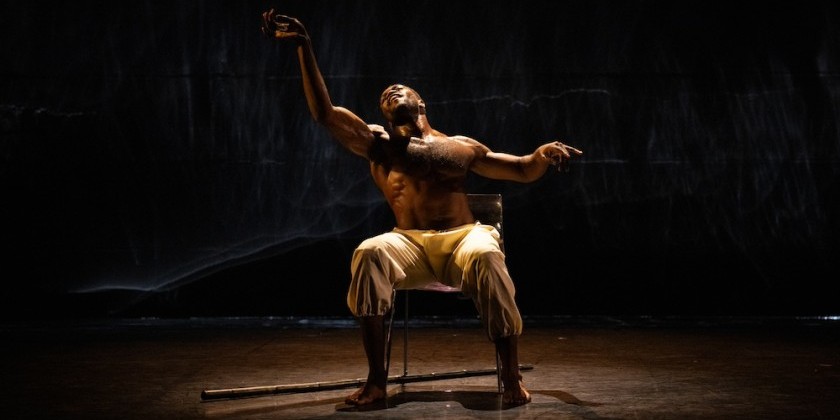IMPRESSIONS: Split Bill #38 at Triskelion Arts with Jendaya Dash and Julia Antinozzi

Impressions: Split Bill #38
Thursday, December 1st, 2022
Triskelion Arts
“For All That You Are”:
Choreography: Jendaya Dash
Performer: Jendaya Dash
Musical Director and Video Editor: Tristan Daley (Digital T)
Sound Mixing: Jordan Daley
Staging and Movement Direction: Kim Grier Martinez
“But, Soft”:
Choreography: Julia Antinozzi
Performers: Sienna Blaw, Alexandra Doyle, Paulina Meneses, Kelsey Saulnier (“But, Soft”)
Costumes: Sonya Gadet-Molansky
Music: Tonstartssbandht, Decker D’Alesio, The Caretaker
Lighting Designer and Technical and Production Manager: Anna Wotring
According to Triskelion Arts’s website, the verb “trisk” means “the process of throwing ideas around & turning them into action.” This notion is clearly present during Triskelion’s bi-annual Split Bill series which offers two NYC based movement artists rehearsal space, marketing support, and production resources to premiere new work. Aptly titled “Split Bill #38,” the show features the work of Jendaya Dash and Julia Antinozzi. While the two works contrast one another in style and presentation, they tackle distinctly human themes of communication and relationships.
The choreographers are popular and the audience’s appetite for live dance is hearty, as evidenced by the sold-out Thursday evening show, with audience members clamoring to get off the waitlist and secure one of the theater’s 78 seats. The show opens with Dash’s “For All That You Are,” a meandering, introspective multimedia work. For All That You Are is a coming-of-age tale told in several chapters, recounting Dash’s journey to regain her voice.
The piece unfolds chronologically, starting with Dash as a child, contently playing with Barbie dolls. On the backdrop, a projection of an old, fuzzy TV shows images of a happy girl, presumably Dash. The image morphs to a young adult at a school dance, and a dramatic, cinematic shift takes place as smoke spills into the theater, creating the impression of a dreamy flashback.
Adolescent angst is easily relatable, even for those of us many years removed, and as Dash sprints around the stage, her desperation is tangible. She attempts to catch something precious in the air, but it eludes her. She falls to her knees, brushing the ground, as though hopelessly searching in the dirt. A snippet of music from the scene in Disney’s The Little Mermaid where Ariel loses her voice suggests a struggle to communicate.

Dash's frantic movement builds in intensity. She throttles onward, finally hitting an apex of frustration, expressed through a blood-curdling scream, a staunch declaration of finality. The lights go out.
As a new chapter begins, red lighting gives the impression of an interrogation: “Why do you always ask me questions you don’t want to hear the answer to??” Dash demands of an imaginary partner. She moves from chair to chair as though attempting to achieve new perspectives on some central object of frustration. Her movement originates from contractions and undulations of her dynamic torso, revealing sorrow and frustration radiating from deep in her center past the confines of her limbs.
Digital T’s score hits us in waves which are both soothing and chaotic, like the sound of automobiles on a faraway highway. When the music changes, Dash falls into a groove, her movements less angsty and more relaxed. As the lights start to dim, Dash is frozen in a wide legged stance, arms wrapped across her chest; in a gesture that conveys both defiance and self-preservation.
Great works of abstraction transcend our literal understanding of the world, hitting us on an emotional level. They are hard to describe and easy to feel. This is especially true of Julia Antinozzi’s “But, Soft,” which closes the evening.
“But, Soft,” is an investigation of romanticism, conveyed through rotating duets. Two dancers begin on the floor, moving in calm unison. Simple movements like walking, skipping, and rolling create captivating patterns as alliances form and disintegrate. The choreography unfolds like the unraveling of a paper snowflake, as the dancers’ loose-limbed explorations reveal shapes which momentarily hold significance and then quickly dissolve. In unison moments, the dancers seem united by a single heartbeat.

Costumes by Sonya Gadet-Molansky are dissimilar in color and design but contain uniting themes. Kelsey Saulnier’s stands out, her white top stained with a red, diffuse circle, suggesting a wound to the heart. The disarray of colors and styles immediately sets the stage with a fun-house-like atmosphere.
As duets surface and dissolve, the dancers interact while maintaining an emotional aloofness. In spite of the physical intimacy of the movement their faces remain stoic. This intentional disassociation creates a distorted reality.
As the piece progresses, each dancer has an opportunity to highlight their individuality through a solo which contrasts the group. Alexandra Doyle’s movement is full of lilting, balletic gestures and dainty twirls, exaggerated by her white tutu. Saulnier’s solo begins with quick, awkward weight shifts, as though she is dodging buried landmines. Her body moves like an accordion, folding in on itself and then extending out towards the edges of the space.
Several gestures, like a splayed hand attempting to open a mouth or one hand hesitantly lifting and descending, imply a struggle to communicate. Other gestures convey emotion like tracing a heart shape and throwing it out to the audience like a blown kiss.

The dancers enter and exit through two steel doors at the back of the stage, which are like portals to a vast beyond. A stark lighting shift suggests the intensity of a nighttime rendezvous. The dancers continue to associate and disassociate in a manner that feels task-oriented, as though puppets controlled by an outside force.
This eeriness of this skewed emotional landscape stays with us when the lights go down.
Through costumes, lighting, and Antinozzi’s keen sense of composition, the theater becomes a very specific world. We sense that we have been granted access to a universe that exists in another dimension, and continues on beyond the close of the piece.






![IMPRESSIONS: [RE]DEFINING [SPACE] at Triskelion Arts](/images/features_small/3_Trisk_day_3_selects_by_caroline_alarcon_loor_064.png)







